TRAPPIST-1 is a cool red dwarf located 40.66 light-years away in the constellation Aquarius. The star hosts seven known extrasolar planets, discovered in 2016 and 2017. Up to four of these planets orbit in the star’s habitable zone, where temperatures allow for the existence of liquid water on the surface, and may be hospitable to life. With an effective temperature of 2,566 K, TRAPPIST-1 is the coolest known star with confirmed exoplanets.
Star type
TRAPPIST-1 is a cool red dwarf star of the spectral type M8V. It has a mass of only 0.0898 ± 0.0023 solar masses and a radius of 0.1192 ± 0.0013 solar radii. It is only slightly larger than Jupiter (0.10045 R☉). With 9% of the Sun’s mass, TRAPPIST-1 is just massive enough to sustain nuclear fusion in its core.
With a surface temperature of 2,566 kelvins, TRAPPIST-1 shines with only 0.000553 ± 0.000018 solar luminosities. The low temperature allows condensates to form it the star’s photosphere. Most of the star’s energy output is the infrared band.
The red dwarf also shows faint emission in the X-ray and ultraviolet part of the spectrum. No radio wave emissions have been detected with the XMM-Newton satellite. There is also no evidence that the star has a stellar cycle.
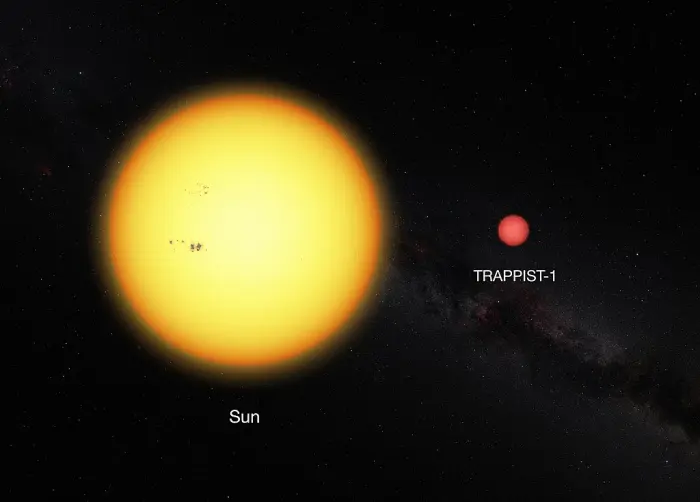
This picture shows the Sun and the ultracool dwarf star TRAPPIST-1 to scale. The faint star has only 11% of the diameter of the Sun and is much redder in colour. Image credit: ESO (CC BY 4.0)
TRAPPIST-1 has an estimated age of about 7.6 billion years. It does not have any companions. It is expected to have a total life span of about 10 trillion years. In comparison, the Sun is about 4.5 billion years old and, due to its higher mass, it will evolve away from the main sequence and enter the late stages of its life cycle in about 5 billion years.
TRAPPIST-1 spins with a projected rotational velocity of 6 km/s, completing a rotation every 3.295 days. The star’s rotational axis might be slightly offset from the rotational axis of the planets orbiting it.
Like all nearby stars, TRAPPIST-1 has a large proper motion.
Observations with the Kepler and Spitzer space telescopes have revealed possible bright spots on the surface of TRAPPIST-1. These hot spots appear to be associated with strong flares in the K2 light curve.
TRAPPIST-1 has a strong magnetic field, which drives high chromospheric activity. The activity is accompanied by frequent stellar flares.
While the parameters of the star’s stellar wind are uncertain, studies published in 2017 and 2018 estimated a mass loss of 3 × 10−14 and 4.1 × 10−15 solar masses per year to the stellar wind.

This diagram compares the sizes of the planets around the faint red star TRAPPIST-1 with the Galilean moons of Jupiter and the inner Solar System. All the planets found around TRAPPIST-1 are of similar size to the Earth. Image credit: ESO/O. Furtak (CC BY 4.0)
Planets
TRAPPIST-1 hosts seven confirmed exoplanets, designated TRAPPIST-1b, c, d, e, f, g, and h. The first two terrestrial planets were discovered during observations with the Transiting Planets and Planetesimals Small Telescope (TRAPPIST) and other telescopes in 2016. The other five planets were identified after further analysis of the observations.
The TRAPPIST-1 planets have masses comparable to that of Earth and lie in the same plane. They orbit the parent star with periods between 1.5 and 19 days at distances of 0.011 to 0.059 astronomical units. All seven planets are closer to TRAPPIST-1 than Mercury is to the Sun.
Astronomers have not detected any moons in the system. The presence of moons is unlikely because the planets are quite close to each other.
The planets have highly circular orbits, which are aligned with the parent star’s spin axis. The inclinations of the orbits relative to the system’s ecliptic are less than 0.1 degrees, which makes the TRAPPIST-1 system the flattest planetary system discovered. The planets transit the star and often pass in front of each other during their orbit when seen from our perspective.
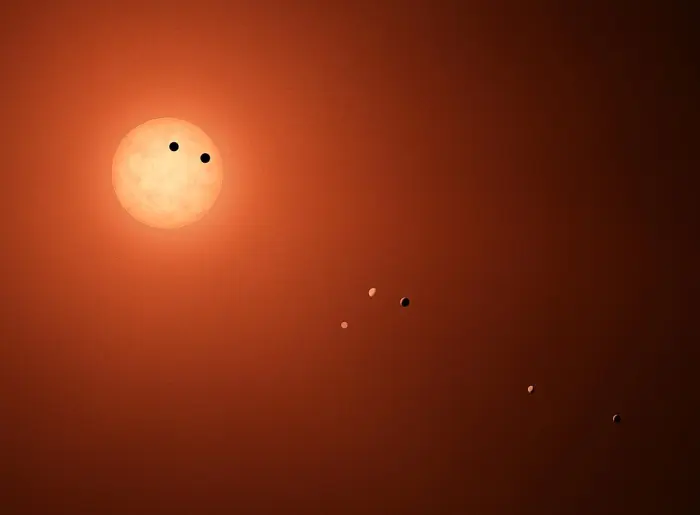
This illustration shows the seven TRAPPIST-1 planets as they might look as viewed from Earth using a fictional, incredibly powerful telescope. The sizes and relative positions are correctly to scale: This is such a tiny planetary system that its sun, TRAPPIST-1, is not much bigger than our planet Jupiter, and all the planets are very close to the size of Earth. Their orbits all fall well within what, in our solar system, would be the orbital distance of our innermost planet, Mercury. With such small orbits, the TRAPPIST-1 planets complete a “year” in a matter of a few Earth days: 1.5 for the innermost planet, TRAPPIST-1b, and 20 for the outermost, TRAPPIST-1h. This particular arrangement of planets with a double-transit reflect an actual configuration of the system during the 21 days of observations made by NASA’s Spitzer Space Telescope in late 2016. Image credit: NASA/JPL-Caltech (PD)
The TRAPPIST-1 planetary system shows orbital resonance, i.e. the orbiting planets exert gravitational influence on each other and the exchange of momentum affects or constrains the planets’ orbits. The durations of the planets’ orbits have ratios of 8:5, 5:3, 3:2, 3:2, 4:3 and 3:2 between the neighbouring pairs. Based on simulations, astronomers believe that such a configuration can stay stable for billions of years.
The interactions between the planets may prevent some of the planets from being synchronized to their host star which, in turn, may improve their odds of habitability.
The planets are believed to be tidally locked to the star, with one side always facing the star and having permanent daylight while the other has permanent night. The orbital elements of the seven planets were calculated using data obtained with the Spitzer and Kepler space telescopes.
The planets are Earth-sized, with radii between 77.5% and 112.9% of Earth’s radius. The mass ratio of the planets and TRAPPIST-1 is comparable to the ratio of the moons and gas giants in the solar system.
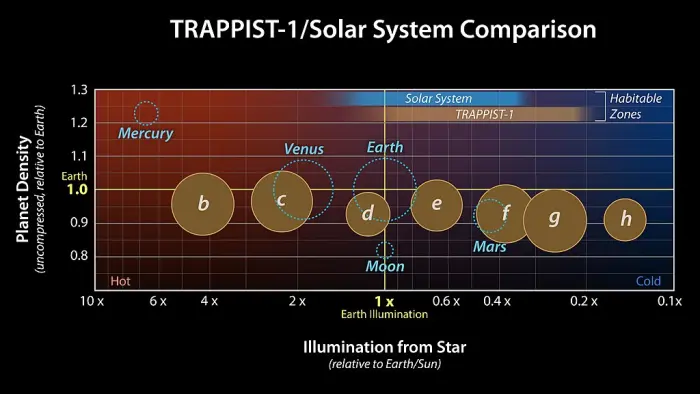
This graph presents measured properties of the seven TRAPPIST-1 exoplanets (labeled b through h), showing how they stack up with one another as well as with Earth and the other inner rocky worlds in our own solar system. The relative sizes of the planets are indicated by the circles. All of the known TRAPPIST-1 planets are larger than Mars, with five of them within 15% of the diameter of Earth. The vertical axis shows the uncompressed densities of the planets. Density, calculated from a planet’s mass and volume, is the first important step in understanding its composition. Uncompressed density takes into account that the larger a planet is, the more its own gravity will pack the planet’s material together and increase its density. Uncompressed density, therefore, usually provides a better means of comparing the composition of planets. The plot shows that the uncompressed densities of the TRAPPIST-1 planets are similar to one another, suggesting they may have all have a similar composition. The four rocky planets in our own solar system show more variation in density compared to the seven TRAPPIST-1 planets. Mercury, for example, contains a much higher percentage of iron than the other three rocky planets and thus has a much higher uncompressed density. The horizontal axis shows the level of illumination that each planet receives from its host star. The TRAPPIST-1 star is a mere 9% the mass of our Sun, and its temperature is much cooler. But because the TRAPPIST-1 planets orbit so closely to their star, they receive comparable levels of light and heat to Earth and its neighboring planets. The corresponding “habitable zones” — regions where an Earth-like planet could potentially support liquid water on its surface — of the two planetary systems are indicated near the top of the plot. The the two zones do not line up exactly because the cooler TRAPPIST-1 star emitting more of its light in the form of infrared radiation that is more efficiently absorbed by an Earth-like atmosphere. Since it takes less illumination to reach the same temperatures, the habitable zone shifts farther away from the star. Image credit: NASA/JPL-Caltech (PD)
The TRAPPIST-1 planets are believed to be composed of large amounts of volatile materials and have low densities. They likely have similar compositions and lower densities than Earth. They may have deep atmospheres and oceans with large amounts of ice.
Because TRAPPIST-1 emits most of its output in the infrared, there may not be much visible light on the planets’ surfaces. Scientists believe that the skies, as seen from the Earth-like planets, are likely fainter than our sky at sunset and a little brighter than ours at night when the Moon is full.
The planets’ proximity to each other would make them appear larger than our full Moon when seen from each other’s surfaces.
Observations with the Hubble Space Telescope in 2017 revealed the first indications of possible water content of the TRAPPIST-1 planets. An international team led by the Swiss astronomer Vincent Bourrier from the Observatoire de l’Université de Genève found that the outer planets in the TRAPPIST-1 system may still contain significant amounts of water, including the three planets orbiting in the goldilocks zone.
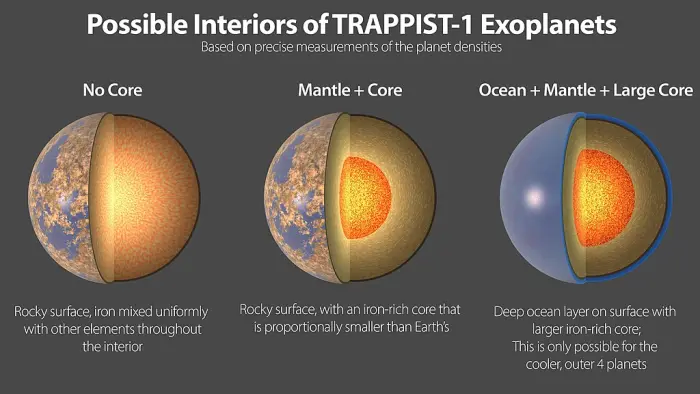
This illustration shows three possible interiors of the seven rocky exoplanets in the TRAPPIST-1 system, based on precision measurements of the planet densities. Overall the TRAPPIST-1 worlds have remarkably similar densities, which suggests they may share the same ratio of common planet-forming elements. The planet densities are slightly lower than those of Earth or Venus, which could mean they contain fractionally less iron (a highly dense material) or more low-density materials, such as water or oxygen. In the first model (left), the interior of the planet is composed of rock mixed with iron bound to oxygen. There is no solid iron core, which is the case with Earth and the other rocky planets in our own solar system. The second model shows an overall composition similar to Earth’s, in which the densest materials have settled to the center of the planet, forming an iron-rich core proportionally smaller than Earth’s core. A variation is shown in the third panel, where a larger, denser core could be balanced by an extensive low-density ocean on the planet’s surface. However, this scenario can be applied only to the outer four planets in the TRAPPIST-1 system. On the inner three planets, any oceans would vaporize due to the higher temperatures near their star, and a different composition model is required. Since all seven planets have remarkably similar densities, it is more likely that all the planets share a similar bulk composition, making this fourth scenario unlikely but not impossible. The high-precision mass and diameter measurements of the exoplanets in the TRAPPIST-1 system have allowed astronomers to calculate the overall densities of these worlds with an unprecedented degree of accuracy in exoplanet research. Density measurements are a critical first step in determining the composition and structure of exoplanets, but they must be interpreted through the lens of scientific models of planetary structure. Image credit: NASA/JPL-Caltech (PD)
The team used Hubble to study the amount of ultraviolet radiation received by the seven planets. UV radiation can break water vapour into hydrogen and oxygen through a process called photodissociation. Hydrogen and oxygen then escape the planetary atmospheres and can be detected by Hubble.
The inner planets – TRAPPIST-1b and TRAPPIST-1c – have possibly lost over 20 times the amount of water contained by the Earth’s oceans in their lifetimes. However, the planets TRAPPIST-1e, f, g, and h, likely lost much less water and may still have some on their surfaces. However, there are still large uncertainties regarding the planets’ water content.
The stellar wind from TRAPPIST-1 may reach deep into the planets’ atmospheres, leading to loss of water. The strong pressure of the wind – possibly up to 1,000 times stronger than the Sun’s at Earth’s orbit – may also cause evaporation of the atmospheres, if there are any.
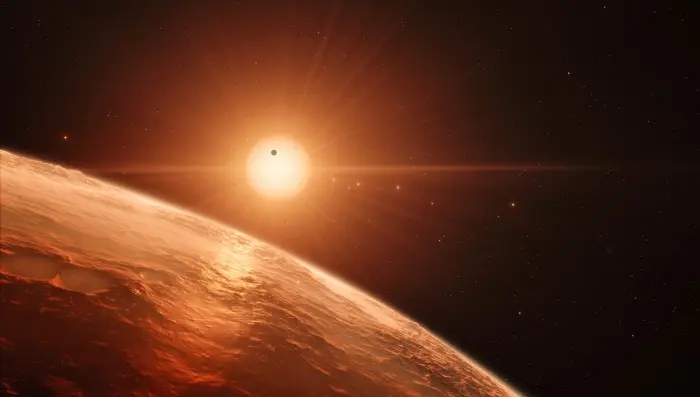
This artist’s impression shows the view from the surface of one of the planets in the TRAPPIST-1 system. At least seven planets orbit this ultra cool dwarf star 40 light-years from Earth and they are all roughly the same size as the Earth. They are at the right distances from their star for liquid water to exist on the surfaces of several of them. Image credit: ESO/M. Kornmesser (CC BY 2.0)
Habitable zone
The habitable zone of TRAPPIST-1 lies within 0.024 to 0.049 astronomical units (AU) of the star. Three or four planets may orbit in the habitable zone, at distances where temperatures allow for liquid water to exist on the surface. However, none of the seven planets show evidence of an atmosphere and it is uncertain whether the radiation from the star would allow for the presence of one.
The planets that might be hospitable to life are TRAPPIST-1e, f and g, or TRAPPIST-1d, e and f. This is the largest number of planets discovered to date orbiting in the habitable zone of a star. The outer planets are too cold to harbour life on the surface, but they may have subsurface oceans that are hospitable to some form of life.
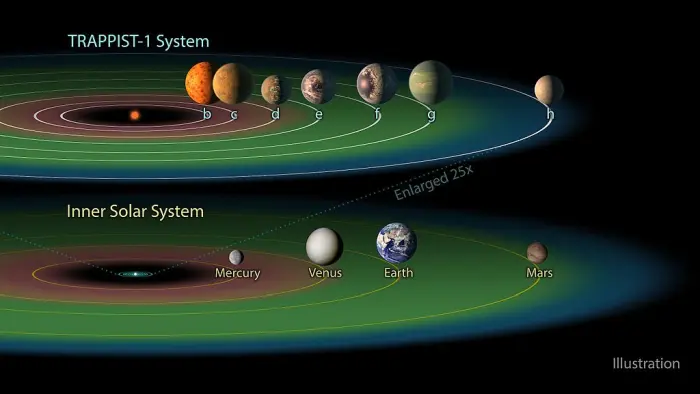
The TRAPPIST-1 system contains a total of seven planets, all around the size of Earth. Three of them — TRAPPIST-1e, f and g — dwell in their star’s so-called habitable zone. The habitable zone, or Goldilocks zone, is a band around every star (shown here in green) where astronomers have calculated that temperatures are just right — not too hot, not too cold — for liquid water to pool on the surface of an Earth-like world. While TRAPPIST-1b, c and d are too close to be in the system’s likely habitable zone, and TRAPPIST-1h is too far away, the planets’ discoverers say more optimistic scenarios could allow any or all of the planets to harbor liquid water. In particular, the strikingly small orbits of these worlds make it likely that most, if not all of them, perpetually show the same face to their star, the way our moon always shows the same face to the Earth. This would result in an extreme range of temperatures from the day to night sides, allowing for situations not factored into the traditional habitable zone definition. The illustrations shown for the various planets depict a range of possible scenarios of what they could look like. Image credit: NASA/JPL-Caltech (PD)
TRAPPIST-1b
TRAPPIST-1b is the nearest planet to TRAPPIST-1. It is a predominantly rocky planet with a mass of 1.374 Earth masses and a radius of 1.116 Earth radii. It is the most massive of the known TRAPPIST-1 planets.
TRAPPIST-1b orbits TRAPPIST-1 with a period of 1.510826 ± 0.000006 days (36 hours) at a distance of only 0.01154 astronomical units (1.72 million kilometres), corresponding to about one hundredth the Earth’s orbital distance. In comparison, Mercury, the innermost planet of the solar system, has an orbital period of 88 days.
TRAPPIST-1b gets approximately four times the amount of energy from its parent star that Earth gets from the Sun. Of all the planets in the TRAPPIST-1 system, it is the one most likely to be composed of bare rock.
The planet is too close to the star to be habitable. In 2023, observations with NASA’s James Webb Space Telescope revealed that it does not have a significant atmosphere. Webb’s Mid-Infrared Instrument (MIRI) measured the planet’s thermal emission in the form of infrared light and found a dayside temperature of around 500 K.
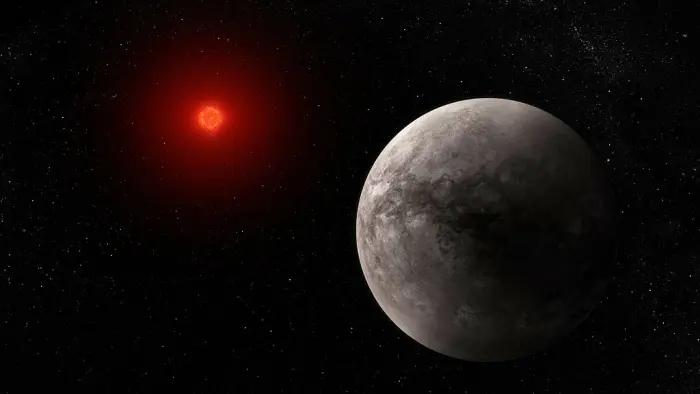
Illustration showing what the hot rocky exoplanet TRAPPIST-1 b could look like. Credit: NASA, ESA, CSA, J. Olmsted (STScI), T. P. Greene (NASA Ames), T. Bell (BAERI), E. Ducrot (CEA), P. Lagage (CEA) (CC BY 4.0)
The rocky exoplanet was previously observed with the Hubble and Spitzer space telescopes. Neither telescope detected a puffy atmosphere, but astronomers could not rule out a dense one.
The JWST observations of TRAPPIST-1b also found that the planet has a low albedo, the fraction of light that it reflects. Scientists have ruled out the presence of an extended gas envelope both for TRAPPIST-1b and TRAPPIST-1c.
TRAPPIST-1b is exposed to the stellar wind and radiation of the host star that would likely leave it without a hydrogen-dominated atmosphere. Astronomers have proposed that it may be a lava planet, one covered mostly or entirely by molten lava.
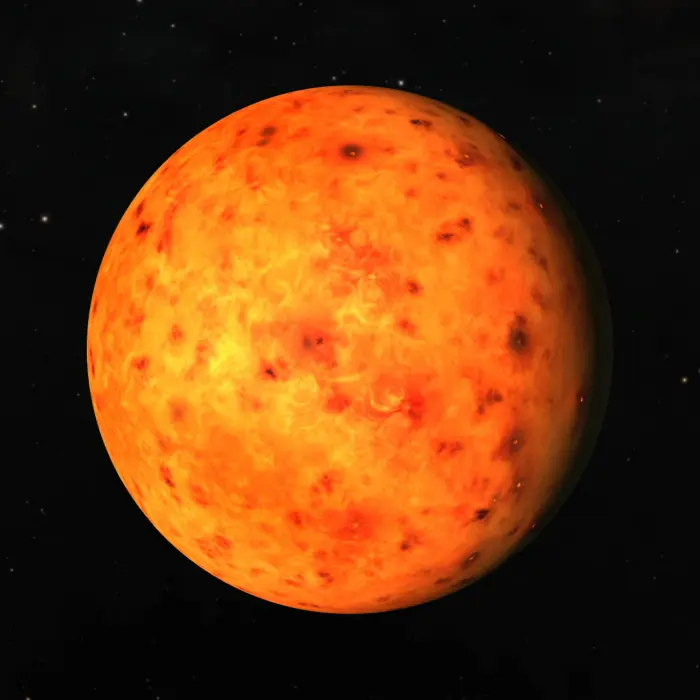
Artist’s impression of the exoplanet TRAPPIST-1b, located in the Aquarius system of TRAPPIST-1. Originally created for NASA as part of their announcement of discoveries in the TRAPPIST-1 system on 22 February 2017. According to NASA, the planet was modeled after Jupiter’s moon Io, “which has volcanic features due to strong gravitational tugs.” Image credit: NASA/JPL-Caltech (PD)
TRAPPIST-1c
TRAPPIST-1c is a rocky planet with a mass of 1.308 Earth masses and a mean radius of 1.097 Earth radii. It has a similar density to Earth. It orbits TRAPPIST-1 with a period of 2.421937 ± 0.000018 days at a distance of 0.01580 astronomical units.
TRAPPIST-1c has an equilibrium temperature of 339.7 K and is too hot to allow for liquid water to form on its surface. Like TRAPPIST-1b, it orbits too close to its parent star. It has a similar orbital period and eccentricity to Io, the innermost of the four Galilean moons of Jupiter. The planet gets twice as much stellar irradiation as Earth.
Observations with the James Webb telescope in 2023 ruled out the presence of a thick carbon dioxide atmosphere and a Venus-like atmosphere. However, the planet may still have a thick abiotic oxygen-dominated atmosphere or water vapour-rich atmosphere.
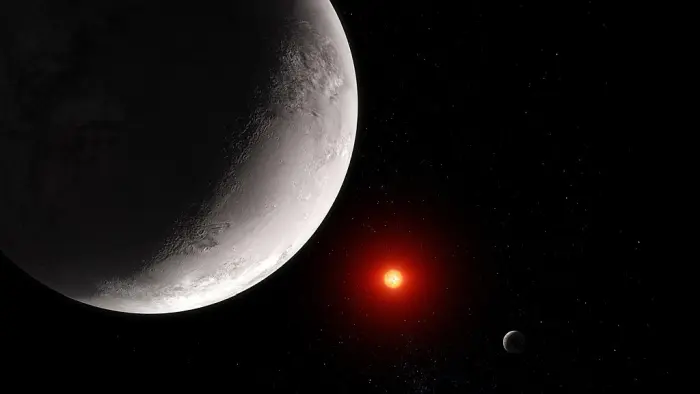
This artist’ concept shows what the hot rocky exoplanet TRAPPIST-1 c could look like based on this work. TRAPPIST-1 c, the second of seven known planets in the TRAPPIST-1 system, orbits its star at a distance of 0.016 AU (about 1.5 million miles), completing one circuit in just 2.42 Earth-days. TRAPPIST-1 c is slightly larger than Earth, but has around the same density, which indicates that it must have a rocky composition. Webb’s measurement of 15-micron mid-infrared light emitted by TRAPPIST-1 c suggests that the planet has either a bare rocky surface or a very thin carbon dioxide atmosphere. Illustrated in the background is TRAPPIST-1 b, the innermost planet in the TRAPPIST-1 system. TRAPPIST-1 b is also rocky and appears to have no substantial atmosphere. The star, TRAPPIST-1, is an ultracool red dwarf (M dwarf) with a temperature of only 2,550 kelvins (about 4,150 degrees Fahrenheit) and a mass just 0.09 times the mass of the Sun. This illustration is based on new data gathered by Webb’s Mid-Infrared Instrument (MIRI) as well as previous observations from other ground- and space-based telescopes. Webb has not captured any images of the planet. Image credit: NASA, ESA, CSA, Joseph Olmsted (STScI) (PD)
TRAPPIST-1d
TRAPPIST-1d is a small planet orbiting close to the inner edge of the habitable zone of TRAPPIST-1. It has a mass 38.8% that of the Sun and a radius 78.8% the Sun’s. It orbits the host star with a period of 4.049219 ± 0.000026 days at a distance of 0.02227 AU, in the inner part of the star’s conservative habitable zone.
TRAPPIST-1d is one of the least massive exoplanets detected to date. Astronomers believe that it has a hydrogen-poor atmosphere similar to that of Venus, Earth or Mars. Orbiting on the inner edge of the goldilocks zone, the planet receives only 4.3% more sunlight than Earth gets from the Sun. Astronomers have proposed that it is a Venus world with a dense, uninhabitable atmosphere. The planet is more massive than Mars, but less dense.
TRAPPIST-1d has an equilibrium temperature of 286.2 K. Less than 5 percent of its mass is composed of volatile materials, which could indicate an atmosphere, ice layers, or oceans. The planet gets 1.043 times the amount of sunlight that Earth does.
TRAPPIST-1d is a candidate eyeball planet, i. e. a tidally locked planet with features that make it look like an eyeball. These features could be liquid on the side facing the star, where the rest of the planet’s surface is covered with ice and rocks, or water on the night side (facing away from the host star), where the day side is made of rock and too hot to sustain water.
Seen from TRAPPIST-1d, TRAPPIST-1 would appear 5.5 times larger than the Sun as it appears from Earth.
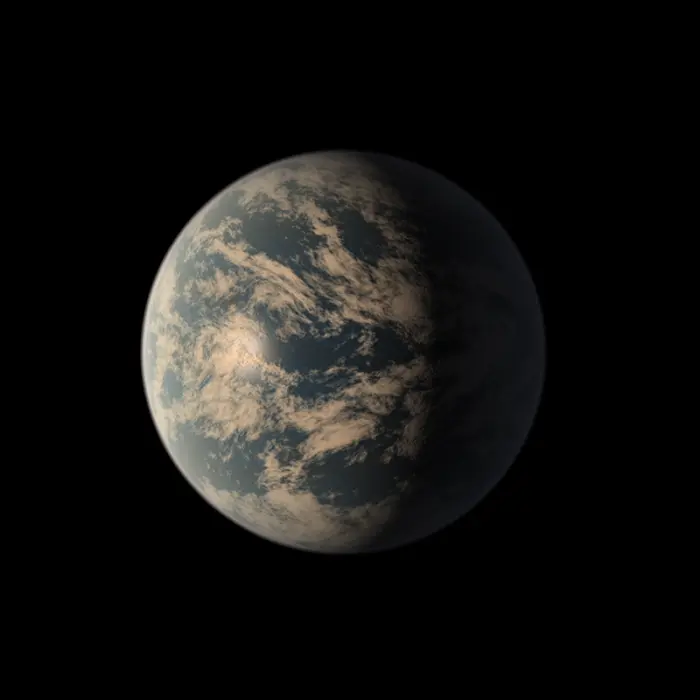
TRAPPIST-1d illustration, image: NASA/JPL-Caltech (PD)
TRAPPIST-1e
TRAPPIST-1e a terrestrial rocky planet orbiting in the habitable zone of TRAPPIST-1. It has a solid, rocky surface and is cool enough to allow for liquid water to pool on the surface. It has a mass of 0.692 Earth masses and a radius of 0.920 Earth radii. It orbits the star with a period of 6.101013 ± 0.000035 days at a distance of 0.02925 AU. It receives a stellar flux 60.4% that of Earth.
The planet has an equilibrium temperature of 249.7 K, similar to that of the Earth (255 K), and a surface gravity 81.7% that of Earth. If it has a thick atmosphere, its surface is likely much warmer than its equilibrium temperature. However, it is possible that the planet does not have an atmosphere.
TRAPPIST-1e is known not to have a cloud-free hydrogen-dominated atmosphere, which makes it more likely to have a compact atmosphere similar to that on the terrestrial planets in our solar system.
Of the seven TRAPPIST-1 planets, TRAPPIST-1e is the most likely to be an Earth-like ocean planet. It is the only planet in the TRAPPIST-1 system that is denser than Earth. The planet’s density is consistent with a solid rock-iron composition.
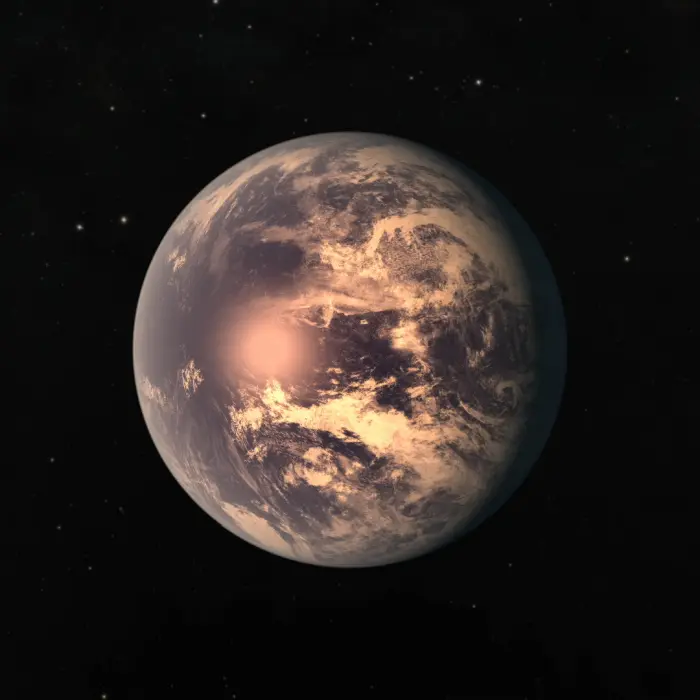
Artist’s impression of the exoplanet TRAPPIST-1e, located in the Aquarius system of TRAPPIST-1. Originally created for NASA as part of their announcement of discoveries in the TRAPPIST-1 system on 22 February 2017. According to NASA, both TRAPPIST-1e and TRAPPIST-1f are depicted as “covered in water, but with progressively larger ice caps on the night side.” Credit: NASA/JPL-Caltech (PD)
The planet is one of the best candidates for habitability discovered to date. It is also one of the best-known potentially habitable planets to the wider public, along with Proxima b in the Proxima Centauri system in the constellation Centaurus, Luyten b (Gliese 273b), a super-Earth orbiting Luyten’s Star in Canis Minor, Ross 128b, an Earth-sized exoplanet orbiting the red dwarf Ross 128 in Virgo, GJ 1061 c and d in the GJ 1061 system in Horologium, Teegarden b and c in the Teegarden Star system in Aries, Wolf 1061b and c orbiting the red dwarf Wolf 1069 in Ophiuchus, and Kepler-69c, a super-Earth orbiting the Sun-like star Kepler-69 in Cygnus.
However, a 2024 study found that the planet’s short orbit around the star may drive a lot of atmospheric heating, which could affect the planetary atmosphere escape rate. In other words, the planet’s atmosphere may be in the process of being stripped by the star’s stellar wind due to the planet’s rapid orbital motion, which would eventually make the planet inhospitable to life.
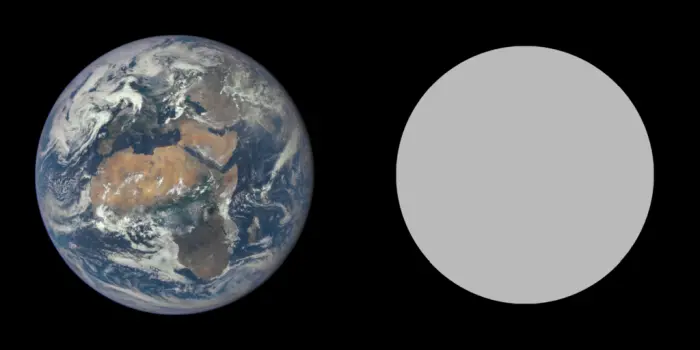
Size comparison of Earth and TRAPPIST-1 e. The exoplanet is depicted with a radius of 0.920 Earth radii (Agol et al. 2021). Credit: Wikimedia Commons/Seven Spheres (CC BY 4.0)
TRAPPIST-1f
TRAPPIST-1f is believed to be a rocky planet orbiting TRAPPIST-1 from a distance of 0.03849 AU. The planet has an orbital period of 9.207540 days. Its orbital distance is over ten times smaller than Mercury’s (0.38 AU).
TRAPPIST-1f has a mass of 1.039 Earth masses and a radius of 1.045 Earth radii. It has an equilibrium temperature of 217.7 K. Like TRAPPIST-1d, it is a candidate eyeball planet. It has a surface gravity about 62% that of Earth.
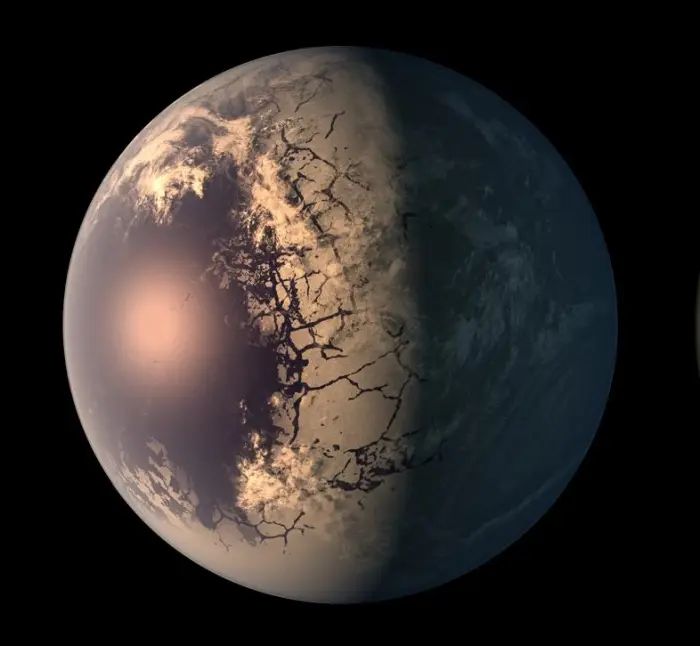
TRAPPIST-1f, image credit: NASA/JPL-Caltech (PD)
A 2017 study proposed that up to 20% of the planet’s mass may be a water ocean, based on the planet’s density. However, observations with the Spitzer Space Telescope in 2021 allowed astronomers to refine the density estimates for the planet. They found that TRAPPIST-1f was only slightly less dense than Earth, which suggests a rocky composition. The study was published in The Planetary Science Journal.
Astronomers believe that TRAPPIST-1f likely has a thick ocean and an atmosphere rich in abiotic oxygen.
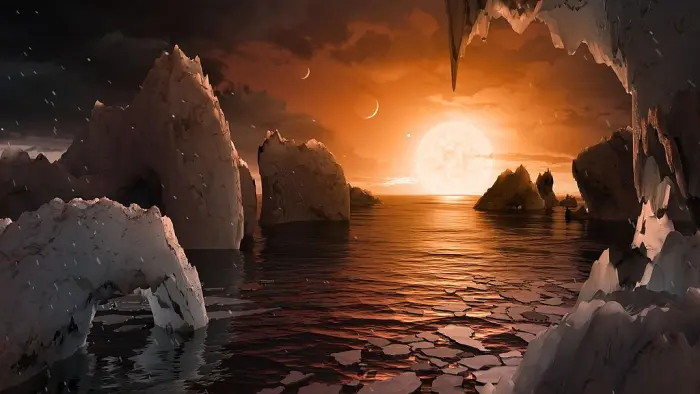
This artist’s concept allows us to imagine what it would be like to stand on the surface of the exoplanet TRAPPIST-1f, located in the TRAPPIST-1 system in the constellation Aquarius. Because this planet is thought to be tidally locked to its star, meaning the same face of the planet is always pointed at the star, there would be a region called the terminator that perpetually divides day and night. If the night side is icy, the day side might give way to liquid water in the area where sufficient starlight hits the surface. One of the unusual features of TRAPPIST-1 planets is how close they are to each other — so close that other planets could be visible in the sky from the surface of each one. In this view, the planets in the sky correspond to TRAPPIST1e (top left crescent), d (middle crescent) and c (bright dot to the lower right of the crescents). TRAPPIST-1e would appear about the same size as the moon and TRAPPIST1-c is on the far side of the star. The star itself, an ultra-cool dwarf, would appear about three times larger than our own sun does in Earth’s skies. NASA’s Jet Propulsion Laboratory, Pasadena, California, manages the Spitzer Space Telescope mission for NASA’s Science Mission Directorate, Washington. Science operations are conducted at the Spitzer Science Center at Caltech, also in Pasadena. Spacecraft operations are based at Lockheed Martin Space Systems Company, Littleton, Colorado. Data are archived at the Infrared Science Archive housed at Caltech/IPAC. Caltech manages JPL for NASA. Credit: NASA/JPL-Caltech (PD)
TRAPPIST-1g
TRAPPIST-1g is a planet with an orbital period of 12.352446 ± 0.000054 days and an orbital distance of 0.04683 AU. It orbits at the outer edge of the host star’s theoretical habitable zone. It receives only 25.2% of the stellar flux that Earth does. If it does not have an atmosphere, TRAPPIST-1g is most likely covered by a thick ice envelope. With a density similar to Earth’s, it is probably a rocky planet.
TRAPPIST-1g has a mass of 1.321 Earth masses and a mean radius of 1.129 Earth radii. It has an equilibrium temperature of 197.3 K. It has the least eccentric orbit of the TRAPPIST-1 planets, which means that its climate is probably very stable.
Because it is orbits farther away from TRAPPIST-1, the planet is believed to have retained a significant amount of its primordial steam atmosphere and likely contains a thick ocean and an atmosphere of abiotic oxygen.
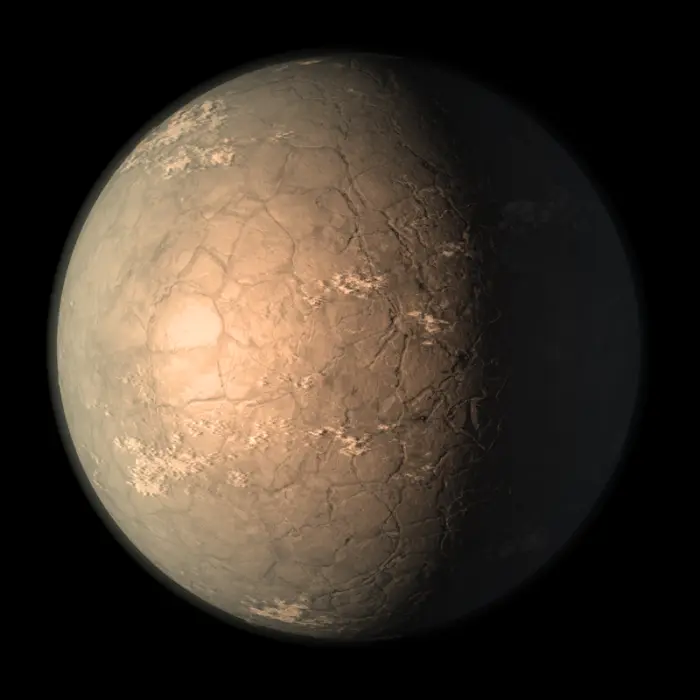
Artist’s impression of TRAPPIST-1g planet, as of 2018. Image credit: NASA/JPL-Caltech (PD)
TRAPPIST-1h
TRAPPIST-1h is the outermost and least massive of the seven known planets in the TRAPPIST-1 system. It orbits the parent star at a distance of 0.06189 AU and has an orbital period of 18.772866 ± 0.000214 days. It has an equilibrium temperature of 171.7 K.
Even though it is the most distant of the seven planets, TRAPPIST-1h has an orbital distance over six times smaller than that of Mercury (0.38 AU). The planet’s orbit is near the host star’s frost line, but the planet may nonetheless contain liquid water if it has a hydrogen-rich atmosphere. Even though observations with the Wide Field Camera 3 on the Hubble Space Telescope (HST) in 2021 and 2022 disfavoured the presence of such atmosphere, the planet may still have a subsurface ocean.
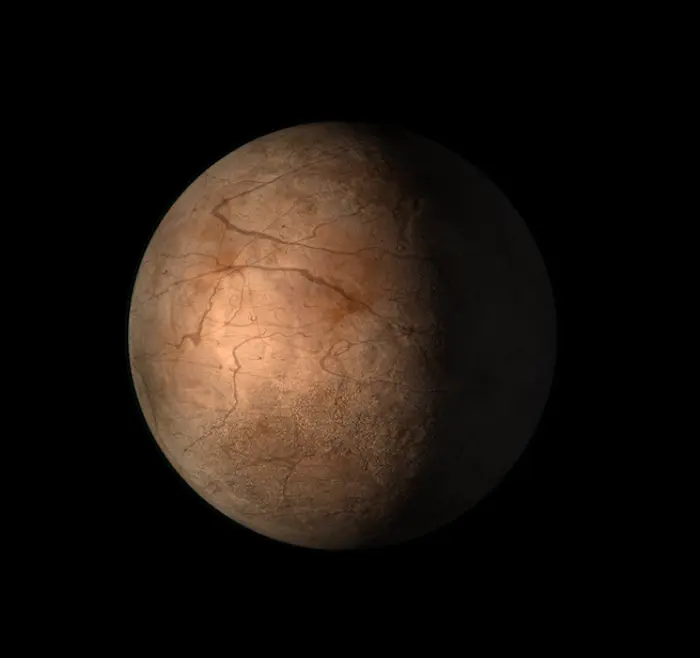
Artist’s impression of TRAPPIST-1h planet, as of 2018. Image: NASA/JPL-Caltech (PD)
TRAPPIST-1h has a mass of 0.326 Earth masses and a radius of 0.755 Earth radii. The planet’s density is relatively low, which means that it is probably water-rich. Since the planet receives only around 13% the stellar flux that the Earth does, the water is probably in the form of thick ice.
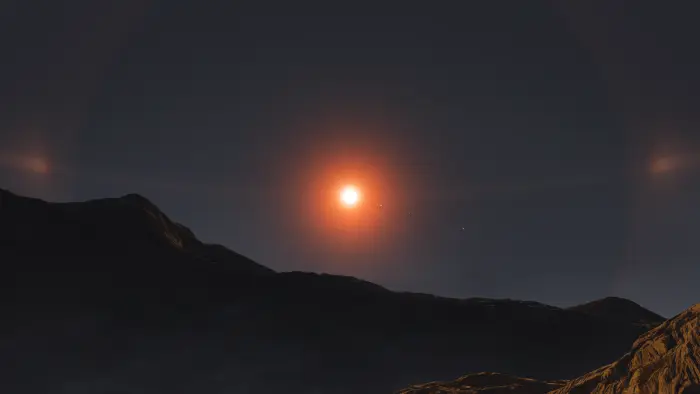
A simple view from the seventh exoplanet orbiting the star TRAPPIST-1. Five other exoplanets are visible as points of light in the sky. Image credit: Judy Schmidt (CC BY 2.0)
Facts
The discovery of TRAPPIST-1 was reported in 2000. The red dwarf star was discovered by a team led by astronomer John Gizis of the California Institute of Technology (Caltech) in 1999. The team combined data obtained in the Two Micron All-Sky Survey (2MASS) and the Second Palomar Sky Survey (POSS II) to search for nearby ultracool dwarfs and followed up with spectroscopic observations. TRAPPIST-1 was one of the 53 red dwarfs identified by the study. The astronomers assigned the star the spectral class M7.5.
The planetary system of TRAPPIST-1 was discovered by Belgian astrophysicist Michaël Gillon at the University of Liège, Belgium, in 2016. The discovery was reported in the journal Nature on February 23, 2017.
Gillon and his team detected anomalies in the light curves of TRAPPIST-1 during observations with the TRAPPIST telescope at the La Silla Observatory in Chile in 2015. They initially explained the anomalies as indicating the presence of three exoplanets. However, in 2016, the third planet was revealed to be multiple planets.
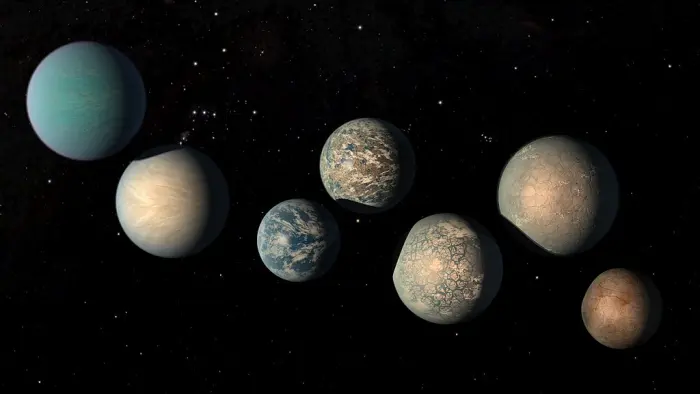
This illustration shows the seven Earth-size planets of TRAPPIST-1, an exoplanet system about 40 light-years away, based on data current as of February 2018. The image shows the planets’ relative sizes but does not represent their orbits to scale. The art highlights possibilities for how the surfaces of these intriguing worlds might look based on their newly calculated properties. The seven planets of TRAPPIST-1 are all Earth-sized and terrestrial. TRAPPIST-1 is an ultra-cool dwarf star in the constellation Aquarius, and its planets orbit very close to it. In the background, slightly distorted versions the familiar constellations of Orion and Taurus are shown as they would appear from the location of TRAPPIST-1 (courtesy of California Academy of Sciences/Dan Tell). Credit: NASA/JPL-Caltech (PD)
The system was observed with the Spitzer Space Telescope, TRAPPIST-North in Oukaïmeden Observatory, Morocco, TRAPPIST-South in Chile, the South African Astronomical Observatory (SAAO) in Sutherland, South Africa, and the William Herschel Telescope and Liverpool Telescope in the Canary Islands, Spain. Subsequent observations were made with the Very Large Telescope (VLT) in the Atacama Desert in northern Chile, the Himalayan Chandra Telescope in Hanle, India, and the United Kingdom Infra-Red Telescope (UKIRT) at Mauna Kea Observatory in Hawaii.
In 2024, a radio technosignature search of the data obtained with the Allen Telescope Array (ATA) in October and November 2022 with the NbeamAnalysis filtering pipeline did not detect any signals of non-human origin. The astronomers looked for signals that occurred during planet-planet occultations, which would allow them to detect any radio transmissions from one planet to another. This was the longest single-target radio search for extraterrestrial intelligence on TRAPPIST-1 to date.
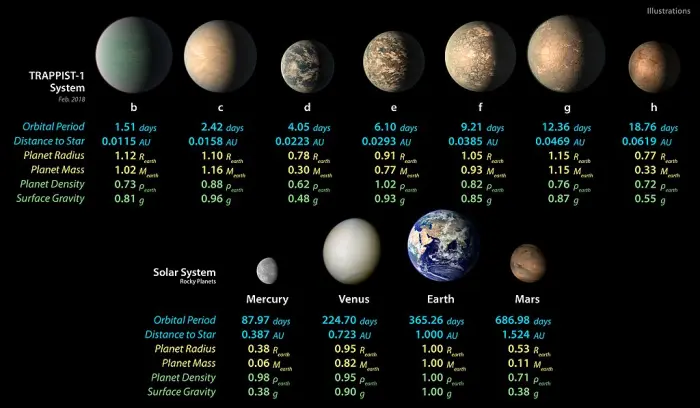
Detailed measurements of the physical properties of the seven rocky TRAPPIST-1 planets and the four terrestrial planets in our solar system help scientists find similarities and differences between the two planet families. Credit: NASA/JPL-Caltech (PD)
Name
TRAPPIST-1 does not have a proper name. The designation TRAPPIST-1 comes from the name of the Transiting Planets and Planetesimals Small Telescope (TRAPPIST), a pair of Belgian optic robotic telescopes that detected the seven orbiting exoplanets around the star in 2016.
The two 24-inch reflecting telescopes – TRAPPIST-North and TRAPPIST-South – are situated at the Oukaïmeden Observatory in the Atlas Mountains of Morocco and at the La Silla Observatory in Chile, operated by the European Southern Observatory (ESO).
The TRAPPIST telescope is a joint venture between the University of Liège, Belgium, and the Geneva Observatory, Switzerland. It is controlled from Liège, Belgum, and specializes in searching for exoplanets and comets.
Location
TRAPPIST-1 lies in the constellation Aquarius, near the border with Pisces. The star appears 5 degrees south of the celestial equator, in the region near the Circlet of Pisces and the Water Jar of Aquarius. Both the Circlet and the Water Jar can be found using the stars of the brighter and larger Great Square of Pegasus.
With an apparent magnitude of 18.798, TRAPPIST-1 is invisible in amateur telescopes.
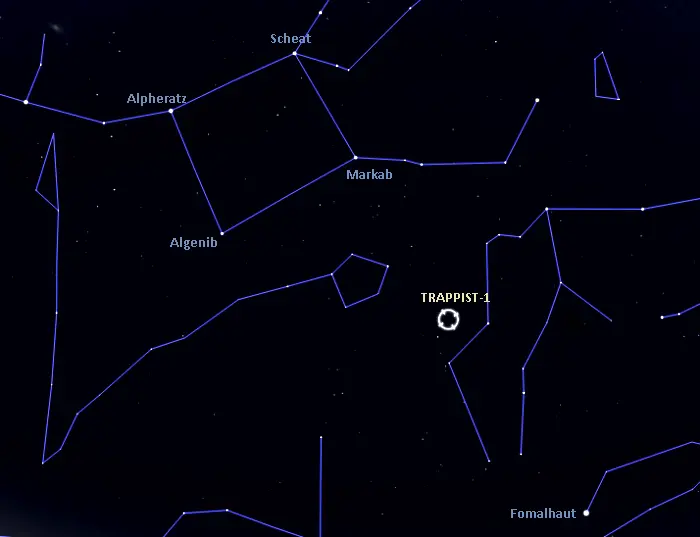
The location of TRAPPIST-1, image: Stellarium
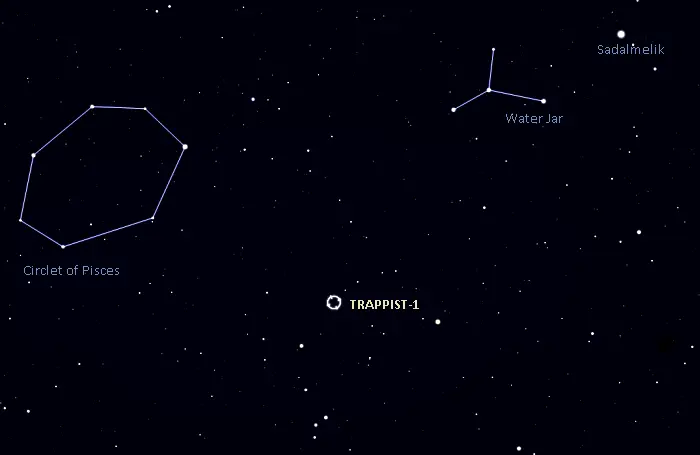
TRAPPIST-1 in Aquarius, image: Stellarium
Constellation
TRAPPIST-1 is located in the constellation Aquarius. The celestial Water Bearer is one of the ancient Greek constellations catalogued by the Greco-Roman astronomer Claudius Ptolemy of Alexandria in his Almagest in the 2nd century CE. In Greek mythology, it is associated with Ganymede, the cup bearer to the gods, as well as with Deucalion, the son of Prometheus who survived a deluge caused by the angry Zeus.
Aquarius is the 10th largest constellation in the sky, stretching across 980 square degrees of the mostly southern sky. It is one of the 15 equatorial constellations and can be seen from most locations for at least part of the year.
Even though it is large, Aquarius is not particularly prominent in the sky. It contains only two stars brighter than magnitude 3.0. These are the luminous yellow supergiants Sadalsuud (Beta Aquarii) and Sadalmelik (Alpha Aquarii). Sadalsuud, the constellation’s brightest star, shines at magnitude 2.87 from a distance of 541.55 light-years.
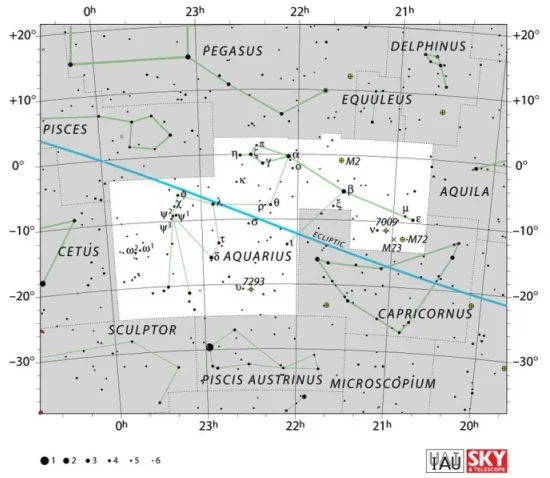
Aquarius constellation map by IAU and Sky&Telescope magazine (Roger Sinnott & Rick Fienberg) (CC BY 3.0)
Other notable stars in the constellation include the A-type main sequence star Skat (Delta Aquarii), the triple star system Zeta Aquarii, the binary stars Gamma Aquarii (Sadachbia), Epsilon Aquarii (Albali) and Xi Aquarii (Bunda), the red giant Lambda Aquarii, the symbiotic star system R Aquarii, the yellow giant or subgiant Ancha (Theta Aquarii), the hot blue giant or subgiant Pi Aquarii, and the triple star system EZ Aquarii, located only 11.11 light-years away.
In addition to TRAPPIST-1, Aquarius hosts several other stars with known planetary systems: the orange dwarf HD 215152 with four confirmed planets, the red dwarf Gliese 849 with two planets, and the yellow dwarf WASP-47 with four planets.
Aquarius contains several relatively bright deep sky objects. These include the famous planetary nebulae NGC 7293 (the Helix Nebula) and NGC 7009 (the Saturn Nebula), the globular clusters Messier 2 and Messier 72, and the peculiar galaxies NGC 7727 and NGC 7252 (the Atoms for Peace Galaxy).
The best time of the year to observe the stars and deep sky objects in Aquarius is during the month of October, when the constellation climbs higher above the horizon in the early evening. The entire constellation is visible from locations between the latitudes 65° N and 90° S.
The 10 brightest stars in Aquarius are Sadalsuud (Beta Aqr, mag. 2.87), Sadalmelik (Alpha Aqr, mag. 2.942), Skat (Delta Aqr, mag. 3.28), Zeta Aquarii (mag. 3.65), 88 Aquarii (mag. 3.679), Lambda Aquarii (mag. 3.722), Albali (Epsilon Aqr, mag. 3.77), Sadachbia (Gamma Aqr, mag. 3.849), 98 Aquarii (mag. 3.97), and Eta Aquarii (mag. 4.04).
TRAPPIST-1
| Spectral class | M8V or M7.5e |
| V-R colour index | 2.332 |
| R-I colour index | 2.442 |
| J-H colour index | 0.636 |
| J-K colour index | 1.058 |
| Apparent magnitude | 18.798 ± 0.082 |
| Apparent magnitude (R) | 16.466 ± 0.065 |
| Apparent magnitude (I) | 14.024 ± 0.115 |
| Apparent magnitude (J) | 11.354 ± 0.022 |
| Apparent magnitude (H) | 10.718 ± 0.021 |
| Apparent magnitude (K) | 10.296 ± 0.023 |
| Distance | 40.66 ± 0.04 light-years (12.47 ± 0.01 parsecs) |
| Parallax | 80.2123 ± 0.0716 mas |
| Radial velocity | -52.003101 ± 0.134416 km/s |
| Proper motion | RA: 930.788 ± 0.087 mas/yr |
| Dec.: −479.038 ± 0.070 mas/yr | |
| Mass | 0.0898 ± 0.0023 M☉ |
| Luminosity | 0.000553 ± 0.000018 L☉ |
| Radius | 0.1192 ± 0.0013 R☉ |
| Temperature | 2,566 ± 26 K |
| Metallicity | 0.04 ± 0.08 dex |
| Age | 7.6 ± 2.2 billion years |
| Rotational velocity | 6 km/s |
| Rotation | 3.295 ± 0.003 days |
| Surface gravity | 5.2396 cgs (5.2323 – 5.2452 cgs) |
| Constellation | Aquarius |
| Right ascension | 23h 06m 29.3684948589s |
| Declination | −05° 02′ 29.037301866″ |
| Names and designations | TRAPPIST-1, K2-112, SPECULOOS-1, EPIC 246199087, 2MUDC 12171, 2MASS J23062928–0502285, 2MASSI J2306292-050227, 2MASSW J2306292-050227, AP J23062928-0502285, TIC 278892590, WISEA J230630.02-050234.1, Gaia DR2 2635476908753563008, Gaia DR3 2635476908753563008 |